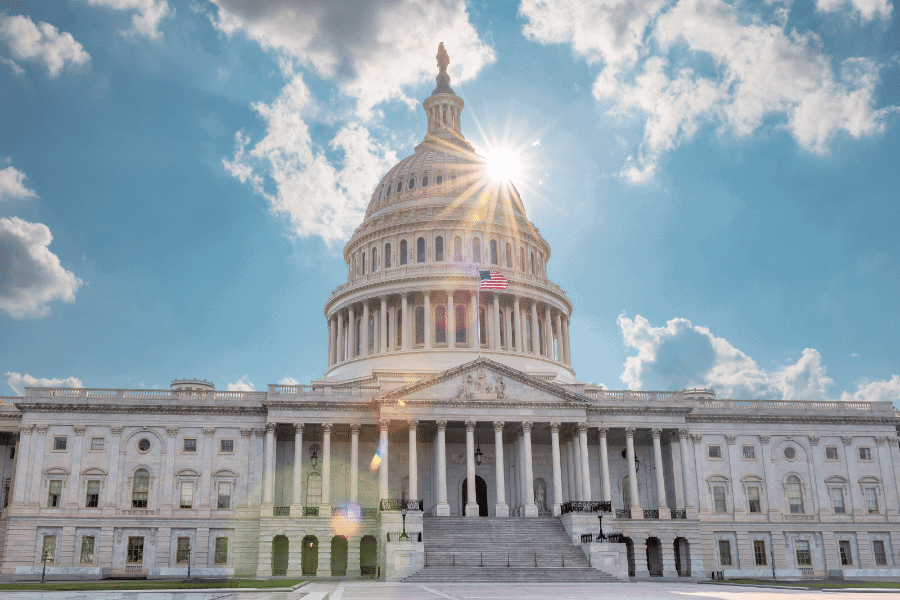The United States EB-5 Visa: the Ultimate Guide
February 5, 2025
Love it or loathe it, the United States is one of the most popular destinations in the world. And we don’t just mean for tourists.
Investors from all over willingly subject themselves to the US’s complex immigration system, wait for years to get approved, and then subject their worldwide income to tax.
What’s so great about any of that?
While those aspects aren’t great, no one can deny the fact that America is a global superpower and, in many ways, still makes the world go around.
Its prestige and wealth make it a place of immense economic opportunity, so foreign investors often choose to ignore the cons and focus on the benefits instead.
And there are many of those:
By obtaining a US EB-5 immigrant investor visa, you and your family can live and work in the United States legally. You can also apply to get naturalised after five years of being a permanent resident.
That’s not to mention the travel benefits, the quality of living and the economic opportunity. However, you must keep in mind that the EB-5 is different from other residence-by-investment programs.
You’ll need to be much more committed – you’ll need to have a US home, maintain your permanent resident status and pay US income taxes as a result.
Ready to take your chance to live in America? If the country is on your radar to invest in and you have US$800,000 available to do so, the EB-5 visa program could be the right permanent residence program for you.
In this article, we will unravel the program’s complex rules, outline the application process, and cover the pros and cons of this visa too.
Why the United States?
We’d wager that since you’re reading this article, you already have a keen interest in living and working in the US and probably don’t need any more convincing.
But if you do, there are so many reasons that the United States is a great place to invest.
The American Quality of Life
America’s standard of living is desired globally. It conjures up images of spacious homes, green lawns, large vehicles and copious amounts of food in most people’s heads.
But there’s more to it than that.
Take healthcare or education, for example. Even though they are expensive, many of the world’s best universities, hospitals and medical professionals are in the US.
The OECD Better Life Index ranks the US 8th in the world on many quality-of-life measures, above New Zealand and the UK.
You don’t have to stay in the United States either. As an official US person, you can travel to most countries in the world for free.
The US passport has some drawbacks, but it also offers some of the best travel benefits in the world. And that freedom undoubtedly adds to the quality of your life.
Endless economic opportunity
You probably know about a little something about the ‘American Dream’.
Well, even though it might be an artificial construct, many people in the world still want a slice of it.
The United States has more Fortune 500 companies than any other country in the world, including most of the world’s tech giants.
It also has a stock market and a real estate market deemed to be among the best and safest investments in the world right now.
Little wonder, then, that so many want to call America their home.
Of course, no economy is perfect, and government debt, as well as poor fiscal health, has seen the United States fall to 25th place in the Index of Economic Freedom.
The United States EB-5 Visa
Many Americans are acutely aware of how they’re taxed on their worldwide income, no matter where in the world they live.
So, many choose to renounce their citizenship and obtain another one in a country that makes more sense.
Then, they try to find ways to still have access to the homeland by obtaining an investment visa.
Besides the E-2 visa, the EB-5 is the most effective way to do so.
The EB-5 is arguably the easiest and the fastest way to get a green card for yourself and your family.
However, not every EB-5 applicant is an American. In fact, from the applicant data, it’s clear that the vast majority of applicants are Chinese nationals.
The other three countries with the most applicants are Vietnam, India and Taiwan.
Large numbers of people also come from South Korea, Hong Kong and South Africa.
If you discount the pandemic years, data shows that the United States has handed out an increasing number of EB-5 visas in recent years.
More than 12,000 applications were accepted in 2024 as a result of a rollover of unused applications from previous years. To date, this visa program has raised well over US$1 billion in EB-5 foreign capital investment.
A Brief History of the EB-5 Visa
Set up in 1990 to ‘create jobs for US workers and infuse capital into the economy’, the EB-5 visa has gone through a few changes over the years.
It’s been transformed from a hands-on program that had hard-to-meet requirements to one that is now more investor-friendly.
In 1993, Congress introduced changes to the EB-5 visa that allowed foreign investors to put money into pre-approved regional centres (public or private). These centres would then manage the money instead of the investor.
Of course, the regional centres charge administration fees, making millions from large projects in the process.
Still, this was a more favourable scenario to many investors; it required no active management of a new business.
And just like that, an entrepreneurial visa became an investor visa.
But then the trouble began.
In the late 1990s, the EB-5 was temporarily suspended due to an elaborate fraud scheme run by Interbank in Virginia that lured hundreds of investors to the United States and left them in limbo for years with their money gone.
A slump in the numbers applying for the EB-5 visa followed for almost a decade after.
But, beginning in 2008, high-net-worth individuals started showing interest again. Just as the Great Recession of 2009 hit, more and more folks wanted to invest and live in the United States.
And so, the EB-5 program was revived, but it was still generating much less money than Congress had hoped. So, they started making changes to the program – again.
By 2011, the number of applications had nearly quadrupled, from 800 in 2007 to 3,800 in 2011.
By August 2014, the government had to stop taking applications because it had reached their annual quota.
The boost was mostly due to wealthy Chinese investors who participated in the EB-5 on behalf of their young adult children, an academic study found.
The EB-5 visa program underwent further changes in 2019, when the investment amount was increased from US$1 to US$1.8million and from US$500k to US$900k in Targeted Employment Areas.
Most recently, in 2022, then-President Joe Biden introduced the EB-5 Reform and Integrity Act, which reduced the investment criteria to US$1.05 million or US$800,000 in so-called poor areas in need of development.
How to Apply for an EB-5 Visa: a Step-By-Step Guide

The EB-5 visa application process is clearly set out but extremely bureaucratic and takes a lot of time and effort.
For one reason or another, US immigration officers seem to believe that their country is the most desirable in the entire world.
This mindset and the belief that it’s up to them to prevent anyone from entering the country (if they can help it) means there is a highly bureaucratic process to apply for and be approved for a United States EB-5 visa.
It takes around two years to get approved for your permanent residence. After that, you will be able to legally travel to and settle in the US with your family.
Here are the steps you need to take.
Step 1: Can You Apply for the EB-5 Visa?
The first step in the process is to make sure you’re eligible to apply.
So, who can apply for an EB-5 visa? You must:
- Be at least 18 years of age
- Be in good health (i.e. no communicable diseases)
- Have at least US$800,000 to invest
- Be able to prove the legality of your funds.
If you’re familiar with residence-by-investment programs, you’ll notice something unusual in the above list.
With the EB-5, unlike in other countries, you don’t need to have any prior business experience to apply.
This is because you won’t be expected to run an actual business. Since you can invest in a project with managers who do the ‘boots on the ground’ work for you, all that is required of the foreign investor is having the cash.
A qualifying investor is able to bring a spouse (must be married at the time of conditional or unconditional green card issue; common-law partnership not allowed), as well as unmarried children under the age of 21.
It also includes the step-children and adopted children of the investor, but a parent lineage must be established at the time when the investor gets admitted to the United States conditionally (or at the time when conditions are lifted).
Step 2: Choose Your Investment
There is actually no real choice involved with your EB-5 investment asset class. The only thing you choose is which part of the country you would like to invest in and whether you’d like to take a hands-on or a hands-off approach.
You may invest US$800,000 of capital cash in a Targeted Employment Area (TEA) or the larger sum of US$1.05 million outside those TEAs. Capital cash is liquid cash, equipment or inventory.
Keep in mind that the minimum investment sums get reviewed every five years and are adjusted for inflation. The next review is due in 2027.
So, what is a Targeted Employment Area (TEA)?
A TEA is now designated by the US Citizenship and Immigration Services due to cases of gerrymandering in the past. Essentially, people were designating TEAs in wealthy areas of the country via various loopholes.
These days, when the government designates a TEA, it must be:
- A rural area or
- An area that is experiencing high unemployment (at least 150% of the national average unemployment rate).
In addition to choosing the sum and the location of your investment, EB-5 applicants have two ways to make their investment:
A. Set up a new commercial enterprise and create 10 full-time jobs.
This option is for those who want to take a hands-on approach. This was the original purpose of this visa, after all. However, not many foreigners choose this route.
That’s because it’s harder to fulfil the requirement of directly creating 10 full-time jobs than if you choose to invest in a regional centre.
If you take this route, you must fill 10 actual positions by people other than you or your family members.
When choosing this option, you’ll need to set up a new for-profit commercial enterprise, which can be a:
- Sole proprietorship
- Partnership (limited or general)
- A holding company
- Joint venture
- Corporation
- Business trust
- Any other entity, privately or publicly owned
The options are varied, so it depends on what kind of business you would like to run.
You can also invest in a troubled business if you don’t want to create your own. This might be a good option for experienced operators who have a track record of turning businesses around.
A troubled business is defined as one that has existed for a minimum of two years and has incurred a significant net loss (at least 20% of the business’s net worth) during the two-year period before you apply for your EB-5 visa.
Instead of creating 10 new full-time jobs, it will suffice to say that you’re going to help maintain those jobs which would otherwise be gone.
B. Invest in a Regional Centre and create 10 full-time jobs.
If you want to invest US$800,000 but don’t want to actively manage a business yourself, you can invest in a Regional Centre.
It is much easier to fulfil the EB-5 criteria for job creation when you invest this way because indirect positions are also counted if you invest in a Regional Centre.
For example, the construction work of a big hotel project.
A Regional Centre is a private or state entity that has applied and been confirmed as being in need of capital to improve the economic condition of the US and add new jobs or save already existing ones.
Some of the projects that are financed using EB-5 include residential developments, luxury hotels, and even infrastructure projects such as the recently completed I-95-Pennsylvania Turnpike highway.
However, even though the USCIS keeps a list of Regional Centres, they by no means endorse them.
All investments are made at your own risk, so always check that you’re investing in a reputable Regional Centre.
You should always do your own due diligence or, better yet, consult a professional. We can help you sort the wheat from the chaff when it comes to EB-5 Regional Centres.
Step 3: File Form I-526 or Form I-526E
First, you’ll have to fill out and submit Form I-526 as a standalone investor or Form I-526E if investing through a regional centre.
The filing fee is US$11,160 for standalone investors or US$12,160 when investing through a Regional Centre.
It takes approximately 18-24 months to process and approve your application.
You can ask government officials to expedite this process, but it’s only done in truly extraordinary circumstances.
The documents you need to submit alongside your I-526 form are:
- Proof you’ve made the investment.
- Proof you’ve acquired the money for the investment through legal means.
- Proof you’ve invested in an officially designated TEA if investing the smaller sum.
- Proof you’ve directly (or indirectly if investing in a Regional Centre) created or will create at least 10 full-time jobs (within two years).
It’s recommended that you use an experienced immigration attorney to help you prepare suitable documents for this process.
You will be sent a confirmation once the application is received.
If your I-526 application has been rejected, you can file for an appeal.
Step 4: Apply For Your Green Card
You’ll be notified once your I-526 petition has been processed and accepted.
In this case, you’ll need to apply for your conditional Green Card using Form DS-260 if you’re based overseas or Form I-485 if you’re already in the US.
This Green Card will grant you and your dependents two years of residence in the US.
Step 5: File Form I-829 – Lift Your Green Card Conditions
After two years of living in the United States, your conditional green card will expire and you will need to extend your stay in the country.
Since conditional green cards cannot be renewed, you will instead need to file Form I-829 to obtain an unconditional green card.
You may apply for permanent resident status within 90 days of the expiration of your conditional green card, ideally from within the US, as you’ll need to submit your biometrics.
Don’t miss the deadline or you’ll become removable from the United States!
When you file this form, you’ll be given an extension to your residence for six months or until your application is processed, whichever is quicker.
You’ll need the following documents to file:
- Proof that you’ve made and kept your required investment (invoices, bank receipts, state income tax returns, or other documents).
- Proof of job creation (payroll records or other documents).
You’ll be asked many questions about your business on this form.
If you haven’t yet fulfilled all the commitments, some leeway is offered. However, you will be asked to submit evidence that you can create 10 jobs within a reasonable amount of time.
The filing fee associated with this form is US$9,525.
You’ll indicate whether you’re applying on behalf of your dependents as well. If not, they’ll have to submit their own I-829 form or they’ll be removable from the United States.
An unconditional green card is valid for 10 years but can be infinitely renewed.
In essence, you can spend your entire life in the US as long as you keep on fulfilling the green card conditions, such as living in the country for at least 180 days each year.
Step 5: Recoup Your Investment
Once you’re set with your unconditional green card, you may withdraw your investment.
This means that you will get the US$800,000 you’ve invested back. If you’ve invested in a Regional Centre, you will get most of your investment back; they charge administration fees that they use to run the entity.
You and your family members who are in possession of an unconditional green card may then remain in the United States indefinitely.
Alternatives to the EB-5 Visa

The United States has an extensive list of temporary and permanent residence visas, schemes and programs.
In fact, it’s quite convoluted and in most cases, you’ll need to work with an immigration attorney to unravel it all.
However, at Nomad Capitalist, we can give you a quick run-down of all of the permanent residence visa programs that can be deemed as alternatives to the EB-5 visa.
So, if, for whatever reason, you’re not eligible for the EB-5 visa, there is always another option that you could go for instead.
EB-1 for Priority Workers
This visa is geared towards ‘first preference’ workers, i.e. highly skilled people, who work in the fields of:
- The arts
- Science
- Business (multinational managers and executives getting transferred to the United States for a company they currently work for will apply for EB-1 visas)
- Education (including professors and researchers with at least three years of experience; must have a higher education sponsor).
- Athletics.
Your ‘extraordinary ability’ is judged by being at least nationally, but ideally internationally, recognised for achievements in your field.
If you think you fit these criteria, you can apply and receive your EB-1 visa within two years.
EB-2 for Professionals and Persons with Exceptional Abilities
For this visa to apply to you, you must have an active job offer in the United States.
Two categories of people fall under this category:
- A professional holding an advanced degree. Master’s, Ph.D., a professional degree, or at least five years of professional training in your industry.
- A person with ‘exceptional abilities.’ This is someone who can demonstrate a substantial level of expertise in their respective field.
You will need to apply for a job remotely and get an offer, but there are ways around this, too.
For example, the Physician National Interest Waiver program makes it possible for foreign medical professionals to immigrate to the US if they will then work in an underserved area of the US for at least five years.
For most applicants of the EB-2 program, the green card will be available immediately after your application approval.
But, due to the large numbers of applicants from India and China, there is a waiting list for these nationalities. Expect to wait three to ten years to receive your American permanent residence if you’re from either of these countries.
EB-3 for Skilled Workers, Professionals, and Other Workers
If you don’t fit the criteria of the two visas above, you’ll most likely find yourself applying for an EB-3.
Similarly to the EB-2, you will need employer sponsorship to obtain residence.
Here is a non-exhaustive list of the workers that qualify:
- Workers whose positions require 2+ years of training or experience
- Professionals whose position requires at least a Bachelor’s degree
- Unskilled workers
Needless to say, the United States government favours skilled workers. And since there is a quota of 40,000 EB-3 visas issued annually, the higher up the ‘food chain’ you are, the better.
Obtaining US Citizenship
If your goal is to obtain US citizenship, it’s certainly possible through naturalisation.
To be eligible for citizenship by naturalisation, you must have accumulated at least five years as a US permanent resident and spent 30 of the previous 60 months in the US.
On top of that, you must:
- Have good moral character
- Be proficient in basic English
- Pass a US History and Government exam
- Register for military service (males of a certain age)
- Swear allegiance to the US.
While the US permits dual citizenship, the country of your original citizenship might not – you’ll have to find out. If not, you must renounce your original citizenship.
Not sure if you should apply for citizenship or residence? The added benefits of having citizenship are:
- A US passport
- Voting in the elections
- Being entitled to all public benefits
- Holding public office
- Travel outside of the US indefinitely.
Do these benefits make it worth your while to become a citizen? We recommend getting some professional advice before coming to any conclusions.
The Pros and Cons of the United States EB-5 Visa

The EB-5 visa program is a great option for some foreign investors, but it will not be the way forward for everyone.
As a first step in determining whether to take the EB-5 visa further, evaluate the following pros and cons.
The Pros
Permanent residence in the US. While other American visas allow you to do business in the United States, the EB-5 visa gives you, and your entire family, a chance to legally reside in the land of the ‘American dream.’
It’s pretty speedy. When compared to residence programs in Europe where you can get a permit in just a few months, the EB-5 visa seems to take an eternity – just under two years is as fast as it’s going to get. However, in the grand scheme of things that’s a pretty short amount of time.
It’s predictable. Unlike other visa programs where there is an element of surprise (lottery), the EB-5 visa is straightforward. Plus, there’s no need to secure sponsorship from an employer or a family member to be approved for the EB-5.
Bring your family. Your spouse and all unmarried children under the age of 21 can come to the United States with you. They will each have to file the application individually, so even if you leave, your kids can stay in their respective educational institutions if desired.
Recoupable investment. We know that US$800,000 – US$1.05 million isn’t exactly cheap, but you’ll eventually be able to recoup that.
The Cons
Large upfront investment. The amount that you’ll need to invest for residence is huge when compared to some of the other residence-by-investment programs out there. Of course, the United States can charge a premium because it offers a lot in return.
There is a waiting list for certain nationalities. While most foreign investors won’t have to wait for longer than necessary, Indians, Chinese and Vietnamese face a serious wait.
There is an annual quota. Some 7.1% of the employment-based visa quote is allocated to EB-5 visas. That amounts to around 10,000 per year. Since dependents are also counted, spaces fill up quickly.
Physical residence required. The United States requires that you spend at least 180 days per year in the country to maintain your resident status.
Taxed on worldwide income. No matter where you are in the world as a US tax resident (which you have to be to retain permanent resident status), you will be taxed on your worldwide income. Fraud and risk. There have been many cases of fraud and even money laundering associated with the EB-5 program. It doesn’t exactly have a spotless reputation and there are many swindlers out there looking to steal your money. We explore it in more detail below.
Fraud and Corruption Under the EB-5 Visa
Most citizenship and residence by investment programs regularly come under fire.
The EB-5 visa program is no different.
In fact, some of its harshest critics, such as Senator Charles E. Grassley, claim that it’s a program that has ‘long been riddled with corruption and national security vulnerabilities’.
The US Securities and Exchange Commission (SEC), the organisation that oversees the EB-5 visa program, has kept a watchful eye throughout the years.
Alarmingly, it has uncovered several major cases of fraud in the past. For example:
- In 2016, the SEC filed fraud charges against Lobsang Dargey, who took advantage of Chinese investors to the tune of US$136 million via his company Path America.
- Investigators uncovered multiple cases of fraud committed by individuals with ties to Chinese and Iranian intelligence using fake documents.
- SEC’s investigators also uncovered that international fugitives had laundered money via the EB-5 program.
- Vermont’s Jay Peak Ski Resort owners misappropriated US$200 million in funds from EB-5 visa applicants, and investors lost all of their money.
Recently, regulation has become more stringent. Due to the fraud, the organisations tasked with supervising the program now conduct audits and even site visits to make sure projects are running legally.
Even though the EB-5 visa program was reformed, the job creation aspect was introduced, and the minimum investment thresholds have been upped significantly, there is no doubt that the program is still far from perfect.
If you’re doing everything legally, you have very little to worry about.
That said, investors are at risk of losing their capital if they invest in fraudulent projects. The best way to avoid that? Consult a professional team that knows the ins and outs of the EB-5 program – give us a call.
The United States EB-5 Visa: FAQs
An EB-5 visa is a document that allows business investors to enter, live and work in the United States.
For most nationalities, there is currently no waiting list. However, that can change at short notice. That said, investors from Vietnam, India, and China have extensive waiting lists and are advised to apply for different visas instead.
You must invest at least US$800,000 in a business and create at least 10 jobs for US citizens or legal permanent residents.
There is an annual quota which limits the government to giving out around 10,000 EB-5 visas per year to foreign investors.
Theoretically, you can, but it’s such a bureaucratic tangle that we would strongly recommend you don’t. Not only can it have a negative impact on your financial situation, but you can also experience delays or even a rejection of your application. It’s best to leave it to professionals to put together packs of documentation, aid you in selecting an investment project, and fill out the application itself.
To apply for an EB-5 visa, you’ll need to pay a US$11,160 processing fee. You’ll also have to invest at least US$800,000 in a US business, although this investment is ultimately recoupable.
The minimum investment is US$800,000 in a Targeted Investment Area or US$1.05 million outside of these areas.
No. Investors from all over the world can apply and don’t need to speak English to get approved. If you don’t speak English, however, it’s essential to hire a professional to aid you in filling out the application for the EB-5 visa.
No, an EB-5 investor doesn’t need a sponsor to apply and obtain a green card.
Yes, one of the eligibility requirements for all EB-5 investors is that you must be in good health. You must prove that you don’t have any infectious diseases and that you have all of the required vaccinations prior to applying.
An EB-5 investor will first receive a conditional green card that will expire in two years and cannot be renewed. You can then apply for an unconditional one that will be valid for 10 years and can be renewed as many times as you need.
Generally, yes. You can apply for an EB-5 visa even if you’ve been rejected for another visa once or multiple times in the past. The only thing that would disqualify you from applying is if you were found to be taking part in immigration fraud.
Your spouse and unmarried children under the age of 21 can also come and live in the country with you as a foreign investor.
It takes approximately 15-18 months for foreign investors to get approved for their conditional Green Card. After that, they can move to the United States legally.
It takes 24 months for the government officials to adjudicate this petition. Your investor status is valid for as long as your form is getting processed.
As well as the usual requirements of being an adult in good health and with no criminal record, you must prove that your funds have come from a legal source. That is one of the main eligibility criteria. All applicants will also go through background checks and submit their biometric information to be run through various databases.
As your conditional Green Card is about to expire (within 90 days), you or your immigration lawyer will file the I-829 form.
Yes. You need to make the entire investment before you fill out the I-526 application. This means that you need to invest the money, and only then will you be considered for residence status in the United States.
You will need to set up an escrow account and wire the money to it. You will then get a receipt that your investment has been made; submit the receipt with your I-526 application.
It must be money that you’ve sourced legally and have paid all tax on through lawful business, salary , investment, sale of real estate, inheritance or a loan. The money can even be gifted to you by a parent or a relative, in which case you’ll need to trace it back to its lawful origin.
Yes. The EB-5 visa program allows you to get all of the money that you invested back once the project that you’ve invested in is completed successfully. Based on experience, we estimate that it takes about four to five years to recoup your original investment.
Yes. Once you receive your conditional permanent resident status, you will be expected to spend at least 180 days in the United States each year. There are some exceptions, such as a medical emergency or a study period abroad. Spending this long in the country will make you a tax resident of the United States.
Yes. The United States is one of the few countries that tax your worldwide income no matter where you live. However, that usually doesn’t mean that you’ll be taxed twice because the US has double taxation agreements with many countries.
The EB-5 visa allows you to access a conditional Green Card that lasts two years. This can eventually be exchanged for an unconditional Green Card that lasts ten years and is infinitely renewable.
Eventually, yes. You can apply for and receive your US citizenship as soon as you become eligible after five years of holding your residency. You will need to meet all of the other naturalisation requirements.
Go Where You’re Treated Best
The United States is a country that many Nomad Capitalists shun. But for some investors out there, it presents an unrivalled opportunity.
The EB-5 visa is a gateway for thousands of foreigners to invest in the United States and have the chance to live there in return.
And just like other residence-by-investment programs around the world, it has its pros and cons.
It’s up to you to evaluate those by yourself, at least initially.
But what you probably shouldn’t take on yourself is the nuance of the US immigration system. It’s highly complex and contains decades’ worth of legislation that investors must comply with.
In this article, we’ve only scratched the surface of all the rules, regulations, and exceptions.
If you want to commit to actually doing the EB-5 for real’, you’re going to need help.
We can assess your personal and financial situation and goals – whether that’s a second passport, a low tax rate, or new investment opportunities – and determine whether the EB-5 visa makes sense for you.
To take control of your life and go where you’re treated best – get in touch with the Nomad Capitalist team.


How to Get UAE Citizenship – The Complete Guide
Sovereignty – both national and personal – shapes ambition, secures wealth, and defines status in a shifting global order. For the high-achieving global citizen, acquiring a second or even third passport is more than a lifestyle upgrade; it’s a strategic move in long-term financial and geopolitical positioning. But not all citizenships are created equal – […]
Read more

A Gateway to Central Asia: New Kazakhstan Golden Visa Program for 2025
Central Asia just raised the stakes in the golden visa game. In May 2025, Kazakhstan officially launched a 10-year Golden Visa program in an ambitious move to position the country as a serious contender in the global investor migration space. At a time when other international regions are rolling back their citizenship and residency options, […]
Read more

Top Countries Offering Golden Visas in 2025
Residency is no longer about lifestyle – it’s about leverage In an increasingly unpredictable world, Golden Visas offer something most governments can’t: certainty in exchange for capital. They are more than migration tools; they are strategic safeguards offering residence rights, future citizenship, global mobility, and access to tax-friendly jurisdictions. For investors, entrepreneurs and globally minded […]
Read more




